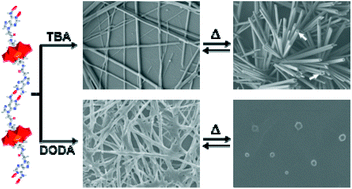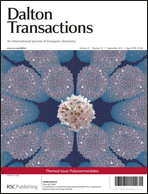A new kind of organic–inorganic hybrid complexes based on polyoxometalate were synthesized through symmetrically grafting two adeninyl groups onto Anderson-type MnMo6 clusters and encapsulating the clusters by organic surfactants. The resultant complexes exhibited thermal-induced dynamic self-assembly behaviors which greatly depended on the ambient temperature and the chain length of cationic surfactants. With the encapsulation of a short surfactant tetrabutyl ammonium, the complex assembled into fibrous, rod-like, and tubular architectures respectively upon heating; while for the case of using a long surfactant dimethyldioctadecyl ammonium as counter ions, the assemblies of the complex transformed from fibers to spheres with the increased temperature. Moreover, the two types of transformations were both reversible during a cooling process. The related mechanism was investigated by combining multiple characterization methods including X-ray crystallography, XPS, FT-IR and temperature-dependent 1H NMR, which indicated that such a thermal-induced morphological transformation resulted from a synergy effect of the variation of the multiple hydrogen bonds among the complexes and the rearrangement of the surfactants surrounding the MnMo6 clusters. These results demonstrated a new concept that hydrogen bonds can be rationally employed as the driving force for the fabrication of polyoxometalate-based materials with smart responsive properties.

You have access to this article
 Please wait while we load your content...
Something went wrong. Try again?
Please wait while we load your content...
Something went wrong. Try again?


 Please wait while we load your content...
Please wait while we load your content...